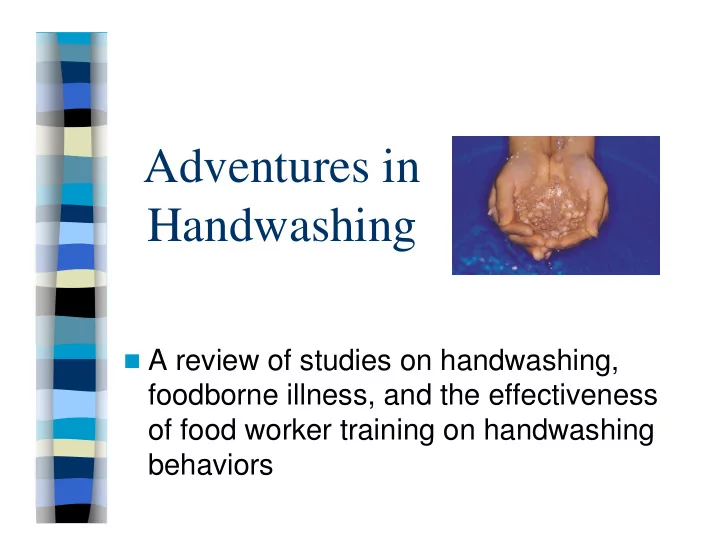

Adventures in Handwashing � A review of studies on handwashing, foodborne illness, and the effectiveness of food worker training on handwashing behaviors
Many Foodborne Pathogens are Associated with Personal Hygiene – Shigella (91%) – Hepatitis A (96%) – Norovirus (78%) – Giardia (100%)
Norovirus is a Common Problem CDC estimates that noroviruses cause 23 million cases of acute gastroenteritis per year in the US.
Norovirus is Common in Foodborne Outbreaks � Of 232 outbreaks of Norovirus between July 1997 and June 2000: – 57% were foodborne – 16% were spread person-to-person – 3% were waterborne.
Norovirus is Most Common in Facilities that Sell Retail Food � Most common settings for Norovirus outbreaks: Restaurants and Catered meals (36%) Nursing homes (23%) Schools (13%) Vacation settings or cruise ships (10%)
Poor Hygiene Affects Food Poor Hygiene Infects People Poor personal hygiene is the 3rd most commonly reported food preparation practice contributing to foodborne disease
It is Important to Keep Hands as Clean as Possible when Handling Food… � … but we can get so busy � …what about hand sanitizers?
Can Food Workers Avoid Handwashing when Busy? The CDC recommended alcohol-based hand gel as a suitable alternative to handwashing for health care personnel in health care settings
The CDC Guidelines Applied only to Health Care Settings � The CDC guidelines regarding hand sanitizers were not intended to apply to food establishments
Why are Hand Gels Used in Hospitals? Common Hospital Pathogens are different to common foodborne pathogens
Why Aren’t Hand Gels Used in Place of Handwashing in Restaurants? � Fecal Pathogens Predominate in Food Service Settings. � Alcohol has a low kill rate for these types of pathogens
Handwashing is Effective on Foodborne Pathogens Soap, friction and running water effectively remove the proteinaceous and fatty materials, and reduce pathogens of concern. * Bare-hand contact is not allowed with RTE foods.
Washing Hands Correctly � Wet your hands with clean running water and apply soap. � Rub hands together to make a lather and scrub all surfaces for 15 seconds. � Ensure fingernails are clean. � Rinse hands well under running water. (5 seconds) � Dry your hands using a paper towel.
Handwashing Reduces Pathogens Microorganisms from Microorganisms from Rinsed Hands Hands Washed Correctly
So Why Aren’t Trainings More Effective? Current ‘knowledge-based’ handwashing training programs do not address barriers to handwashing practices during operations.
What Stops Employees from Washing Their Hands? Lack of accountability Lack of involvement of manager/coworkers Workplace was not supportive of handwashing
What Stops Employees from Washing Their Hands? Time pressure Inadequate facilities Inadequate supplies
Food Safety Practices at a Food Service
Observed 906 handwashing events by video camera at 10 different angles: � 6.1% acceptable � 93% unacceptable � 78% paper towel use
Observed 787 Cross-contamination events � 11% direct � 89% indirect
Busy = Risky Rush times: � During the rush time there was less handwashing, and almost none. � Handwash areas often turned into storage areas during rush times. � Hours between 8-9 and 12-1 had the most cross-contamination
Bacterial Counts Were Done on Food Workers Hands Bacterial populations on kitchen workers hands increased significantly after 1 hour and 1.5 hours. Soap AND Sanitizer worked better.
Bacterial Counts Were Also Done on Food Workers Gloves 3. Bacterial populations on hands AND gloves increased after 1.5 and 2 hours. 4. Washing and Sanitizing every hour was effective in maintaining a low bacterial load on hands and gloves.
Is ‘Passive’ Training Adequate?
Interactive Training Works Better Study Results: Participants involved in the interactive training had better test performances both on the day of training and on the two- week retest.
Recommendations for training programs � Hands-on training program that orients new employees to correct handwashing practice � More advanced education about foodborne illness
Recommendations for training programs � Involvement of both managers and coworkers in the training
Recommendations for training programs � Easily accessible handwashing facilities stocked with supplies (hot and cold water, soap, paper towels)
Recommendations for training programs � Continued handwashing training and support involving the food service industry, managers, and coworkers
Recommendations for training programs � Involvement of health departments and inspectors in providing managers and food workers with advice and consultation on improvement of handwashing practices.
Thank you!
Recommend
More recommend